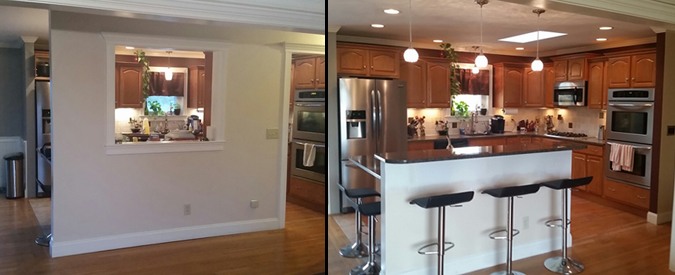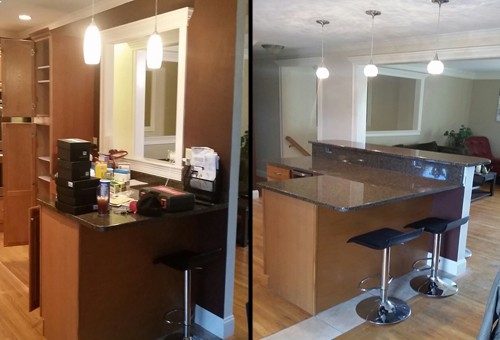Last Updated: February 14, 2023
How Much Does It Cost to Remove a Wall in My Home?
Find a Renovation Pro
Fill out our 30 second free form to receive competitive pricing from pre-screened contractors. No commitments. Our service is always free!
Load Bearing vs Non-Load-Bearing Wall Considerations
As homeowners continue to favor open-concept layouts, removing interior walls has become a popular project. Removing a wall is a much more affordable option than major renovation for opening up your living areas and improving flow.
But before you grab that sledgehammer and go to town, it’s crucial to know the difference between a load-bearing and non-loading-bearing wall, and how that impacts your project. It’s also important to understand what’s inside the wall. In some cases, removing a wall can be a DIY project, but often it’s best left to contractors, architects and/or structural engineers.

Load-Bearing vs. Non-Load-Bearing Walls
Interior load-bearing walls rest on the foundation, bearing the load of the house and everything above the wall, from the second floor (if there is one) to the roof. Removing one can seriously compromise the structural integrity of your house, potentially collapsing it. You should always consult a professional before removing a wall or having it removed to determine if it is load bearing. Professionals contractors can often make the call, but consult a structural engineer if there’s any uncertainty.
Load-bearing walls can be removed, but the job requires creating additional support. Most often, a beam or a steel girder is used to support the load of the home. Sometimes, columns will do the trick. This is very rarely a DIY job, unless you’re an experienced contractor. The consequences of doing it wrong can be devastating and costly. Keep in mind, too, that removing a load-bearing wall in a two-story home is more difficult and costly than removing one in a single-story home.
However, not all interior walls are load bearing. Some interior walls were built simply to separate rooms or create privacy, and are not crucial to the structure. This is far more common in older homes. Smaller, separated rooms used to be both practical, due to the cost of heating less efficient homes, and fashionable.

Find a Renovation Pro
Fill out our 30 second free form to receive competitive pricing from pre-screened contractors. No commitments. Our service is always free!
What’s Inside the Walls?
Even if the wall is not load bearing, you need to consider what is inside of it before the sledgehammer swings. The last thing you want to do is swing into gas lines, water pipes or electric wires. What’s inside the wall may also help determine whether you really want to remove it. Lines, pipes and HVAC can all be moved, but that adds significantly to the total project cost. Moving vents can also impact the efficiency of your heating and cooling systems, making the home less comfortable.
You also need to consider the impact taking down the walls will have on nearby flooring. Will you need to redo the flooring completely, or can you fill in the space with matching flooring? That’s a much easier task with carpeting than hardwood.

Costs and Choosing a Contractor
The cost of the project is largely influence by whether the wall is load bearing or not. Other factors that come in to play, to a lesser extent, include: what’s inside the walls, the cost of flooring replacement, regional labor costs, whether you need to bring in a structural engineer or architect, and more. The Houzz guide to removing walls offers these estimates from builder Jeff Andreson:
- $2,500 to $3,000 to remove a non-load-bearing wall and install carpeting
- $10,000 to remove a single-story, load-bearing wall
- $20,000 to $30,000 to remove a two-story, load-bearing wall
Andreson also told Houzz he recommends budgeting an extra 20 percent in case surprises are uncovered when the walls are opened up.
Some people choose to consult an architect when they’re planning to remove a wall. Architects can come up with creative solutions that create more space but involve less extensive work. You’ll pay more upfront for the consultation and design, but you stand to save money on the overall project by reducing construction expenses.
Find the Best Contractors Who Will Compete for Your Business
Find a Renovation Pro
Fill out our 30 second free form to receive competitive pricing from pre-screened contractors. No commitments. Our service is always free!
Find a Renovation Pro
Fill out our 30 second free form to receive competitive pricing from pre-screened contractors. No commitments. Our service is always free!